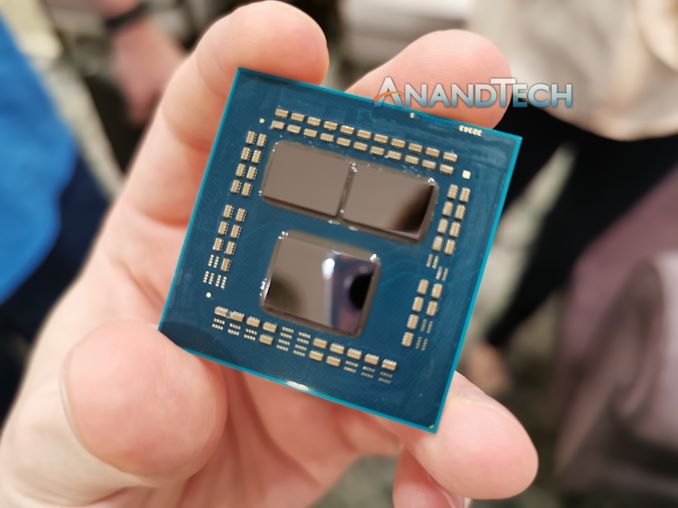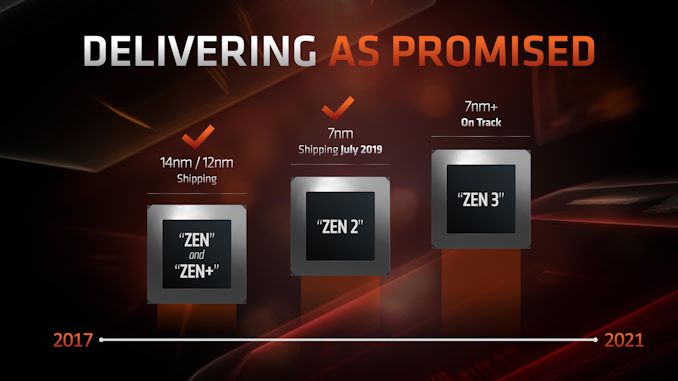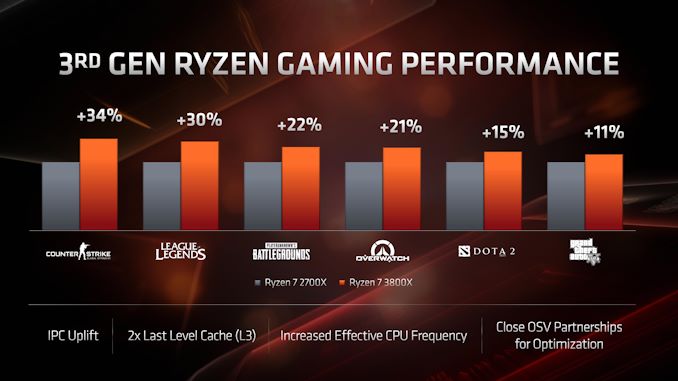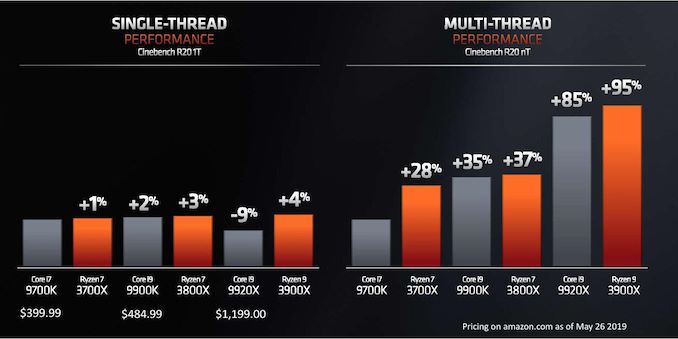The AMD 3rd Gen Ryzen Deep Dive Review: 3700X and 3900X Raising The Bar
by Andrei Frumusanu & Gavin Bonshor on July 7, 2019 9:00 AM EST
It’s the review we’ve all been waiting for. Since December last year – and particularly since CES – AMD has been teasing us about the new Zen 2 microarchitecture and AMD’s newest Ryzen 3000 series of CPUs. Incorporating a significantly upgraded CPU architecture and built using TSMC's latest generation manufacturing process, AMD has continued to run at full speed at a time when rival Intel has struggled to move at all. The end result is that while the first and second generation of Ryzen CPUs were all about AMD returning to competition and eating into Intel's substantial performance lead, the Ryzen 3000 series is nothing less than AMD's first shot in nearly 13 years at meeting (or beating) Intel at their own game in the desktop CPU market. It's a big moment for AMD, and an exciting one in the CPU industry as a whole.
The new Ryzen 3000 chips mark the first "big" leap for AMD since they introduced their first Ryzen processors a bit over two years ago. Unlike last year's Ryzen 2000 series, which was a more minor refresh and brought some tweaks to the microarchitecture and process node, this year’s Ryzen 3000 is a major upgrade for both CPU architecture as well as on the manufacturing node. It marks AMD’s switch from GlobalFoundries' 12nm process to TSMC’s newest 7nm node. But what’s more exciting is how AMD was able to actually implement this switch: Ryzen 3000 isn’t merely a single chip, but a collection of non-uniform chiplets, introducing this design paradigm in a consumer product for the first time.
Today AMD launches its entire new CPU lineup and platform, alongside the new Navi-based Radeon RX 5700 series. In terms of CPU coverage, we’ll be taking a closer look at the new flagship, the $499 12-core Ryzen 3900X, as well as the $329 8-core Ryzen 7 3700X and its peculiar low TDP of 65W.
Updates
- (7/8): We've noticed large frequency boost behaviour changes with new motherboard firmware that was released on launch day (7/7). We are currently re-running all our test suite numbers and updating the article with the new data soon as applicable. For further details please read here.
- (7/9): We've updated the article benchmark numbers on the 3900X. We've seen 3-9% improvements in exclusive ST workloads. MT workloads have remained unchanged, Gaming had both benefits and negatives. We continue to work on getting updated 3700X numbers. Original BIOS results are marked with ** in the graphs.
- (7/10): We've updated 3700X results as well. Ultimately our conclusions haven't changed, but AMD does narrow the gap a bit more. For a full summary of our findings, please check out this article.
The CPU Line-up
| AMD 'Matisse' Ryzen 3000 Series CPUs | |||||||||||
| AnandTech | Cores Threads |
Base Freq |
Boost Freq |
L2 Cache |
L3 Cache |
PCIe 4.0 |
Chiplets IO+CPU |
TDP | Price (SEP) |
||
| Ryzen 9 | 3950X | 16C | 32T | 3.5 | 4.7 | 8 MB | 64 MB | 16+4+4 | 1+2 | 105W | $749 |
| Ryzen 9 | 3900X | 12C | 24T | 3.8 | 4.6 | 6 MB | 64 MB | 16+4+4 | 1+2 | 105W | $499 |
| Ryzen 7 | 3800X | 8C | 16T | 3.9 | 4.5 | 4 MB | 32 MB | 16+4+4 | 1+1 | 105W | $399 |
| Ryzen 7 | 3700X | 8C | 16T | 3.6 | 4.4 | 4 MB | 32 MB | 16+4+4 | 1+1 | 65W | $329 |
| Ryzen 5 | 3600X | 6C | 12T | 3.8 | 4.4 | 3 MB | 32 MB | 16+4+4 | 1+1 | 95W | $249 |
| Ryzen 5 | 3600 | 6C | 12T | 3.6 | 4.2 | 3 MB | 32 MB | 16+4+4 | 1+1 | 65W | $199 |
AMD is launching 5 different SKUs today, with the 16-core Ryzen 9 3950X set to follow sometime in September. For today's launch AMD sampled the R9 3900X and R7 3700X, and we took them for a ride in the limited time we had with them, covering as much as we could.
Starting at the top we have the Ryzen 3900X, which is a 12-core design. In fact it's the first 12-core processor in a standard desktop socket, and it rather unique within AMD's product stack because it is currently the only SKU which takes full advantage of AMD’s newest chiplet architecture. Whereas all the other Ryzen parts are comprised of two chiplets – the base I/O die and a single CPU chiplet – 3900X comes with two such CPU chiplets, granting it (some of) the extra cores and the 64MB of L3 cache that entails.
Interestingly, while AMD has increased the core-count by 50% over its previous flagship processor, it has managed to keep the TDP to the same 105W as on the Ryzen 2700X. On top of this, the chip clocks in 300MHz faster than the predecessor in terms of boost clock, now reaching 4.6GHz; even the base clock has been increased by 100MHz, coming in at 3.8GHz. The big question then, is whether the new 7nm process node and Zen 2 are really this efficient, or should we be expecting more elevated power numbers?
Meanwhile our second chip of the day is the new Ryzen 3700X, which is configured and positioned as a particularly efficient model. With a boost clock of 4.4GHz and a base clock of 3.6GHz, the part should still be notably faster than the Ryzen 2700X, yet AMD has managed to make this a 65W TDP part which is going to make for some interesting analysis.
Continued Execution
Today’s Zen 2 and Ryzen 3000 launch is another step forward on AMD’s roadmap. The company has been working on a very ambitious development roadmap for their CPU designs, and Zen 2 is the company's first chance to flex their muscles and do a full iteration on their CPU core design.
Executing on this roadmap has been important for AMD both because it's helped them close the performance gap with Intel, and because it's helped to prove to customers (particularly hyperscalers and enterprises) that Zen wasn't a fluke, and that the company can reliably continue to improve its technology. This is especially noteworthy because while rival Intel hasn't been standing still, all of Intel's desktop technology for the last 3 years has been based on the same Skylake core architecture and variations on Intel's exceptional-for-the-time 14nm process. This will eventually change, as Intel gets their desktop house in order for 2020, but right now AMD is moving forward when Intel can not, allowing AMD to take full advantage of Intel's run of bad luck and wooing customers in the process.
And of course, AMD isn't done here. For the company’s engineers, today’s chips are last year’s work, and the company is working on the next generation Zen 3 core. Zen 3 is still a full generation away – and today is all about Zen 2 – but AMD is making it clear that Zen 2 isn't the end of the road either, and that they are working to further improve their CPU microarchitecture and overall platform.
Large Performance Boosts, Particularly for Gaming
The 3rd gen Ryzen processors promise to bring some notably large performance improvements for users. The Zen 2 core microarchitecture is said to bring over 10% IPC improvements; this together with the higher clockspeeds should make for some solid generational improvements in a lot of workloads. For gaming in particular, AMD claims that we should be seeing some large improvements – the doubled size of the L3 cache is said to have made a notable mark on a lot of gaming titles, with AMD claiming ~20% to even ~30% improvements in some titles when compared to the last generation Ryzen 2700X.
The Ryzen 3000 Competition: Intel's Coffee Lake Refresh
Positioning the Ryzen 3000 series against Intel’s line-up is a matter of both performance as well as price. AMD had already made comparisons between the new SKUs and Intel’s counterparts back at Computex, where we saw comparisons between similarly priced units. According to the company, even Intel's pricey Skylake high-end desktop (HEDT) processor, the Core i9-9920X, isn't entirely out of the line of fire of the Ryzen 3900X.
As a quick recap to where things stand, compared to its immediate predecessor, Intel’s Coffee Lake Refresh received quite a bump in terms of both clock frequencies as well core counts. This allowed Intel to erase any Ryzen 2000 series lead in multi-threaded performance, all the while still maintaining a comfortable lead in single-threaded performance.
Against the Ryzen 3000 series, the Intel line-up will seemingly no longer have an IPC lead. AMD hasn’t been in such a situation since the Athlon 64 days well over 15 years ago, which is a remarkable turn of events. But with that said, make no mistake: IPC is just one half of the equation for single-threaded performance, and the other is raw frequency, and the Intel line-up still has a notable advantage thanks to its peak frequencies of up to 5GHz. So taking over Intel's single-threaded performance lead (at least on a consistent basis) is a tall order for the Ryzen 3000 series.
| Comparison: Ryzen 9 3900X vs Core i9-9900K | ||
| AMD Ryzen 9 3900X |
Features | Intel Core i9-9900K |
| 12 / 24 | Cores/Threads | 8 / 16 |
| 3.8 / 4.6 GHz | Base/Turbo | 3.6 / 5.0 GHz |
| 16 (Free) + 4 (NVMe) | PCIe 4.0 Lanes | 16 (Free) Gen 3.0 (No Gen 4.0) |
| 512 KB/core | L2 Cache | 256 KB/core |
| 4x 16 MB 64 MB total |
L3 Cache | 16 MB |
| 105 W | TDP | 95 W |
| $499 (cooler included) |
Price (List) | $484 (no cooler) |
Taking a look at chip pricing and positioning then, the big flagship fight among desktop processors is going to be between the Ryzen 3900X at $499, and the i9-9900K at $484. Both of which happen to be the highest-end SKUs of their respective mainstream desktop computing platforms. It's to remembered that the AMD CPUs come with a good cooler included, while Intel's options don't include one, meaning one would have to spend extra in order to get the Intel system running.
Here AMD should have a significant lead in terms of the multi-threaded performance of the new Ryzen 9 series as it’s able to employ 50% more cores than Intel, all while promising to remain in a similar TDP range of 105W vs 95W. We still expect the 9900K to win some workloads which are more lightly threaded simply due to Intel’s clock frequency lead, however this is something we’ll investigate more in detail in the coming benchmark analysis.
| Comparison: Ryzen 7 3700X vs Core i7-9700K | ||
| AMD Ryzen 7 3700X |
Features | Intel Core i7-9700K |
| 8 / 16 | Cores/Threads | 8 / 8 |
| 3.6 / 4.4 GHz | Base/Turbo | 3.6 / 4.9 GHz |
| 16 (Free) + 4 (NVMe) | PCIe 4.0 Lanes | 16 (Free) Gen 3.0 (No Gen 4.0) |
| 512 KB/core | L2 Cache | 256 KB/core |
| 2x 16 MB 32MB total |
L3 Cache | 12 MB |
| 65 W | TDP | 95 W |
| $329 (cooler included) |
Price (List) | $385 (no cooler) |
The Ryzen 7 3700X is an interesting SKU. With only one populated CPU chiplet, the unit has half the available L3 cache versus the Ryzen 9 3900X. But it also has all the CPU cores within its one chiplet active. In theory this does mean that the CPU cores have less overall L3 cache available to them, as they have to share it with an additional core within their respective CCXs.
With a 3.6GHz/4.4Ghz base/boost clock configuration, we expect the 3700X to outperform the previous generation 2700X in all scenarios. The competition here based on pricing is the Core i7-9700K. Intel again should have a single-threaded performance advantage thanks to its 500 MHz higher clocks – but we’ll have to see how both chips match up in daily workloads.
The Zen 2 µarch Overview: Read Our Dedicated Article
We’ve already posted a microarchitecture overview and analysis of the Zen 2 microarchitecture following our Tech Day briefings in June, so be sure to read the piece in preparation for further testing analysis in our review today:













447 Comments
View All Comments
Death666Angel - Tuesday, July 9, 2019 - link
Well, the thing is that motherboard manufacturers, motherboard revisions, motherboard layout and BIOS versions do play a role as well, though. The memory controller is just one piece of the puzzle. If you have a CPU with a great memory controller, it doesn't mean it performs the same on all boards. And it doesn't mean it performs the same with all RAM either. Sometimes the actual traces on motherboards are crap for certain clockspeeds. Sometimes the BIOS numbers for secondary and tertiary timings are crap at certain clockspeeds and get better in later revisions, seemingly allowing for better memory clockspeeds when it really was just a question of auto vs manual if you knew what you were doing. Sometimes the SoC voltage is worse on that board vs the other and that influences things. The thing is, across the board, X570 motherboards have higher advertised OC clockspeeds for the memory and Ryzen 3000 has higher guaranteed clockspeeds. And Anandtech believes that is the thing that counts, not if you can get x clockspeed stable. At least in the vanilla CPU articles. They do separate RAM articles often.BLu3HaZe - Tuesday, July 9, 2019 - link
"Some motherboard vendors are advertising speeds of up to DDR4-4400 which until Zen 2, was unheard of. Zen 2 also marks a jump up to DDR4-3200 up from DDR4-2933 on Zen+, and DDR4-2667 on Zen."How about now? :)
And I believe the authors mean to say that official support for is up to 3200 on X570 boards, while older boards were rated lower "officially" corresponding to the generation they launched with. Speeds above that would be listed with (OC) clearly marked in memory support.
Anything above the 'rated' speeds, you're technically overclocking the Infinity Fabric until you run in 2:1 mode which is only on Zen 2 anyhow, so your mileage will definitely vary.
Even the 9900K 'officially' supports only DDR4-2666 but we all know how high it can go without any issues combined with XMP OC.
Ratman6161 - Wednesday, July 10, 2019 - link
In Zen and Zen +, the infinity fabric speed was tied to the memory speed. So overclock the RAM and you were also overclocking the infinity fabric. In Zen 2 infinity fabric is independent of the RAM speed.Targon - Monday, July 8, 2019 - link
I am curious about the DDR4-3200 CL16 memory in the Ryzen test. CL16 RAM is considered the "cheap crap" when it comes to DDR4-3200, and my own Hynix M-die garbage memory is exactly that, G.skill Ripjaws V 3200CL16. On first generation Ryzen, getting it to 3200 speeds just hasn't happened, and I know that for gaming, CL16 vs. CL14 is enough to cause the slight loss to Intel(meaning Intel wouldn't have the lead in the gaming tests).Ninjawithagun - Monday, July 8, 2019 - link
Regardless of whether or not a 'crap' DRAM kit having CL16 vs. a much more expensive kit with lower CL rating, it isn't going to make any significant difference in performance. This has been proven again and again.Ratman6161 - Wednesday, July 10, 2019 - link
"CL16 RAM is considered the "cheap crap" when it comes to DDR4-3200"Since when? Yes its cheap(er) but I'd disagree with the "crap" part. I needed 32 Gb of RAM so that's either 2x16 with 16 GB modules usually being double sided (a crap shoot) or 4x8 with 4 modules being a crap shoot. Looking at current pricing (not the much higher prices from back when I bought) New egg has the G-skill ripjaws 2x16 CAS 16 kit for $135 while the Trident Z 2x16 CAS 15 for $210 or the CAS 14 Trident Z for $250. So I'd be paying $75 to $115 more...for something that isn't likely to do any better in my real world configuration. Even if I could hit its advertised CAS 15 or 14, how much is that worth. So I'd say the RipJaws is not "cheap crap". Its a "value" :)
Domaldel - Wednesday, July 10, 2019 - link
It's considered "cheap crap" because you can't guarantee that it's Samsung B-die at those speeds while you can with DDR4 3200 MHz CL14 as nothing else is able to reach those speeds and latencies then a good B-die.What that means is that you can actually have a shot at manually overclocking it further while keeping compatibility with Ryzen (if you tweak the timings and sub-timings) while you couldn't really with other memory kids on the first two generations of Ryzen.
I don't have a Ryzen 3xxx series of chip so I can't really comment on those...
WaltC - Monday, July 15, 2019 - link
Since about the 2nd AGESA implementation, on my original x370 Ryzen 1 mboard, my "cheap crap"...;)...Patriot Viper Elite 16CL 2x8GB has had no problem with 3200Mhz at stock timings. used the same on a x47- mboard, and now it's running at 3200MHz on my x570 Aorus Master board--no problems.jgraham11 - Tuesday, July 16, 2019 - link
DDR4 3200 is apparently not an overclock. Says so on AMD's specs page for the 3700Xhttps://www.amd.com/en/products/cpu/amd-ryzen-7-37...
RoboJ1M - Sunday, July 7, 2019 - link
Wait, the memory controllers on the IO for Zen 2, right?I'm sure it's on the IO Die.